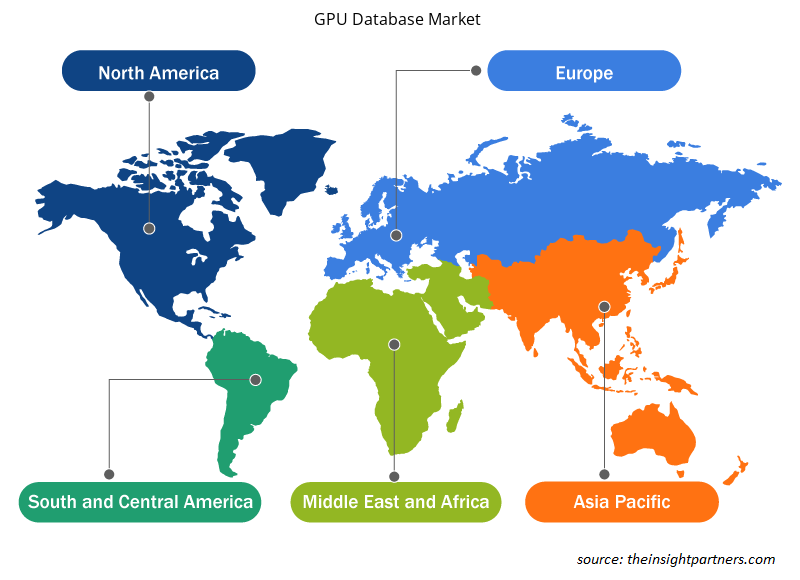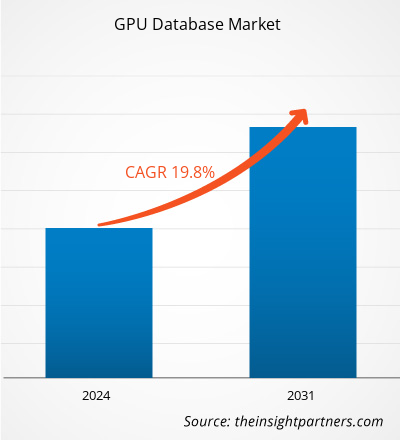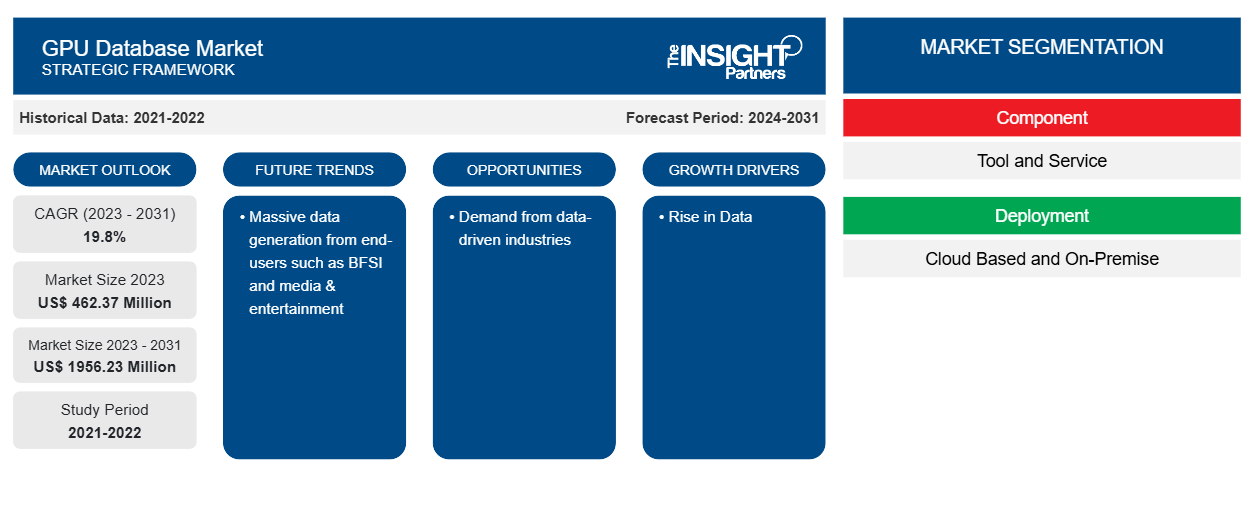Se proyecta que el tamaño del mercado de bases de datos de GPU alcance los 1956,23 millones de dólares estadounidenses en 2031, frente a los 462,37 millones de dólares estadounidenses en 2023. Se espera que el mercado registre una CAGR del 19,8 % durante el período 2023-2031. Es probable que el aumento de los datos y las crecientes industrias impulsadas por los datos sigan siendo tendencias clave en el mercado.
Análisis del mercado de bases de datos de GPU
Las crecientes industrias impulsadas por datos son uno de los principales factores impulsores del mercado de bases de datos GPU. El aumento de la digitalización y la inclinación de las empresas hacia soluciones para procesar grandes conjuntos de datos están impulsando el crecimiento del mercado. La base de datos GPU encuentra su aplicación en algunas de las tecnologías emergentes, como la inteligencia artificial, el aprendizaje automático y profundo, la Internet de las cosas (IoT) y el análisis geoespacial, lo que crea enormes oportunidades para el crecimiento del mercado de bases de datos GPU.
Descripción general del mercado de bases de datos de GPU
Una base de datos GPU utiliza unidades de procesamiento gráfico (GPU) para realizar operaciones de base de datos. Una GPU es un procesador programable diseñado para renderizar rápidamente imágenes y videos de alta resolución. La base de datos GPU procesa grandes volúmenes de datos de manera más rápida y eficaz que las CPU porque funcionan en paralelo en lugar de en secuencia. Por lo tanto, las bases de datos GPU suelen ser más rápidas y están orientadas a la analítica, que es más flexible para procesar muchos tipos diferentes de datos o cantidades mucho mayores de datos.
Personalice este informe según sus necesidades
Obtendrá personalización en cualquier informe, sin cargo, incluidas partes de este informe o análisis a nivel de país, paquete de datos de Excel, así como también grandes ofertas y descuentos para empresas emergentes y universidades.
-
Obtenga las principales tendencias clave del mercado de este informe.Esta muestra GRATUITA incluirá análisis de datos, desde tendencias del mercado hasta estimaciones y pronósticos.
Factores impulsores y oportunidades del mercado de bases de datos GPU
Aumento de datos favorece al mercado
Con la llegada de la digitalización, los datos se generan a un ritmo vertiginoso. Es necesario analizar y procesar datos de diversas variedades, volúmenes y velocidades para extraer información y patrones ocultos con la ayuda de técnicas de análisis de datos . Los análisis tradicionales no proporcionan técnicas y tecnologías de análisis óptimas. Esto genera la necesidad de una base de datos GPU. Con capacidades de procesamiento masivamente paralelas, la base de datos GPU proporciona computación de alto rendimiento de manera rentable. La base de datos GPU es una solución ideal para manejar grandes conjuntos de datos, lo que impulsa la demanda de esta tecnología.
Demanda de industrias impulsadas por datos.
Los datos de la GPU tienen un alto poder de cómputo. Debido a sus capacidades de procesamiento paralelo, pueden procesar datos hasta 100 veces más rápido que las configuraciones que contienen solo CPU, como se ilustra. Por lo tanto, varias industrias impulsadas por datos, como BFSI, medios y entretenimiento, y otras, demandan soluciones para cargas de trabajo de procesamiento intensivo para aplicaciones de análisis de datos, lo que impulsa la demanda de bases de datos de GPU. Los actores del mercado están lanzando soluciones para satisfacer esta demanda. Graphistry lanzó Hub Pro (Graphistry Hub for Professionals) para brindar análisis de gráficos visuales acelerados por GPU a los clientes. Graphistry Hub Pro resuelve problemas de seguridad, precios y mantenimiento para individuos, y las próximas organizaciones Hub para equipos. (Fuente: Graphistry, comunicado de prensa, septiembre de 2021)CPUs, as illustrated. Thus, various data-driven industries such as BFSI, media & entertainment, and others demand solutions to processing-intensive workloads for data analytics applications, which drives the demand for GPU databases. The market players are launching solutions to cater to this demand. Graphistry launched Hub Pro (Graphistry Hub for Professionals) to bring GPU-accelerated visual graph analysis to customers. Graphistry Hub Pro solves security, pricing, and maintenance for individuals, and the upcoming Hub Organizations for teams. (Source: Graphistry, Press Release, September 2021)
Análisis de segmentación del informe de mercado de bases de datos de GPU
Los segmentos clave que contribuyeron a la derivación del análisis del mercado de bases de datos de GPU son componentes, implementación, aplicación y vertical de la industria.
- Según el componente, el mercado de bases de datos de GPU se divide en herramientas y servicios. El segmento de herramientas tuvo la mayor participación del mercado en 2023.
- Por implementación, el mercado se segmenta en basado en la nube y local. Se espera que el basado en la nube crezca con la CAGR más alta.CAGR.
- Por aplicación, el mercado está segmentado en detección y prevención de fraudes, gobernanza, riesgo y cumplimiento (GRC), gestión de la experiencia del cliente, mantenimiento predictivo, gestión de la cadena de suministro, inteligencia de amenazas y otros. La gestión de la experiencia del cliente ocupó una participación significativa del mercado en 2023.GRC), customer experience management, predictive maintenance, supply chain management, threat intelligence, and others. The customer experience management held a significant share of the market in 2023.
- Por sector industrial, el mercado está segmentado en BFSI, TI y telecomunicaciones, comercio minorista y comercio electrónico, atención médica, transporte y logística, gobierno y defensa, entre otros. El BFSI tenía una participación significativa del mercado en 2023.BFSI, IT & telecom, retail & e-commerce, healthcare, transportation & logistics, government & defense, and others. The BFSI held a significant share of the market in 2023.
Análisis de la cuota de mercado de las bases de datos de GPU por geografía
El alcance geográfico del informe de mercado de bases de datos de GPU se divide principalmente en cinco regiones: América del Norte, Asia Pacífico, Europa, Medio Oriente y África, y América del Sur y Central.
Se espera que la región de Asia Pacífico crezca con la CAGR más alta. El aumento de la digitalización y la creciente demanda de técnicas avanzadas de análisis de datos en economías en desarrollo como India y China están impulsando el crecimiento del mercado en la región. La transformación digital en las industrias impulsadas por datos, como BFSI, atención médica, fabricación y otras, impulsa aún más el crecimiento del mercado. La creciente demanda de extracción de información de grandes conjuntos de datos está impulsando el crecimiento del mercado en Asia Pacífico.CAGR. The rise in digitalization and growing demand for advanced data analytics techniques in developing economies such as India and China is driving market growth in the region. Digital transformation across data-driven industries such as BFSI, healthcare, manufacturing, and others, further drives market growth. The increasing demand for extracting insights from large datasets is fuelling the market growth in Asia Pacific.
Perspectivas regionales del mercado de bases de datos de GPU
Los analistas de Insight Partners explicaron en detalle las tendencias y los factores regionales que influyen en el mercado de bases de datos de GPU durante el período de pronóstico. Esta sección también analiza los segmentos y la geografía del mercado de bases de datos de GPU en América del Norte, Europa, Asia Pacífico, Oriente Medio y África, y América del Sur y Central.

- Obtenga datos regionales específicos para el mercado de bases de datos de GPU
Alcance del informe de mercado de bases de datos de GPU
| Atributo del informe | Detalles |
|---|---|
| Tamaño del mercado en 2023 | US$ 462,37 millones |
| Tamaño del mercado en 2031 | US$ 1956,23 millones |
| CAGR global (2023 - 2031) | 19,8% |
| Datos históricos | 2021-2022 |
| Período de pronóstico | 2024-2031 |
| Segmentos cubiertos |
Por componente
|
| Regiones y países cubiertos |
América del norte
|
| Líderes del mercado y perfiles de empresas clave |
|
Densidad de actores del mercado de bases de datos de GPU: comprensión de su impacto en la dinámica empresarial
El mercado de bases de datos de GPU está creciendo rápidamente, impulsado por la creciente demanda de los usuarios finales debido a factores como la evolución de las preferencias de los consumidores, los avances tecnológicos y una mayor conciencia de los beneficios del producto. A medida que aumenta la demanda, las empresas amplían sus ofertas, innovan para satisfacer las necesidades de los consumidores y aprovechan las tendencias emergentes, lo que impulsa aún más el crecimiento del mercado.
La densidad de actores del mercado se refiere a la distribución de las empresas o firmas que operan dentro de un mercado o industria en particular. Indica cuántos competidores (actores del mercado) están presentes en un espacio de mercado determinado en relación con su tamaño o valor total de mercado.
Las principales empresas que operan en el mercado de bases de datos de GPU son:
- BRILLANTE
- GRAFISMO
- H2O.ai
- Jedox
- Kinetica DB Inc.
- Compañía: Neo4J, INC.
Descargo de responsabilidad : Las empresas enumeradas anteriormente no están clasificadas en ningún orden particular.

- Obtenga una descripción general de los principales actores clave del mercado de bases de datos de GPU
Noticias y desarrollos recientes del mercado de bases de datos de GPU
El mercado de bases de datos de GPU se evalúa mediante la recopilación de datos cualitativos y cuantitativos a partir de una investigación primaria y secundaria, que incluye publicaciones corporativas importantes, datos de asociaciones y bases de datos. A continuación, se enumeran algunos de los desarrollos en el mercado de bases de datos de GPU:
- NVIDIA y HP Inc. anunciaron la integración de las bibliotecas de procesamiento de datos NVIDIA CUDA-X con las soluciones de estaciones de trabajo de inteligencia artificial de HP para potenciar el trabajo de preparación y procesamiento de datos que constituye la base del desarrollo de la inteligencia artificial generativa. Basadas en la plataforma de cómputo NVIDIA CUDA, las bibliotecas CUDA-X aceleran el procesamiento de datos para una amplia gama de tipos de datos, incluidas tablas, texto, imágenes y videos. Incluyen la biblioteca NVIDIA RAPIDS cuDF, que acelera el trabajo de los casi 10 millones de científicos de datos que utilizan el software pandas hasta 110 veces utilizando una GPU NVIDIA RTX 6000 Ada Generation en lugar de un sistema solo con CPU, sin necesidad de realizar cambios en el código. (Fuente: NVIDIA, comunicado de prensa, marzo de 2024)
- Zilliz, pionero en tecnología de bases de datos vectoriales , anunció el lanzamiento de Milvus 2.4, que establece un nuevo estándar en capacidades de búsqueda vectorial con una innovadora función de indexación de GPU impulsada por CUDA-Accelerated Graph Index for Vector Retrieval (CAGRA) de NVIDIA, parte de la biblioteca RAPIDS cuVS. (Fuente: Zilliz, comunicado de prensa, marzo de 2024)
Informe sobre el mercado de bases de datos de GPU: cobertura y resultados
El informe “Tamaño y pronóstico del mercado de bases de datos de GPU (2021-2031)” proporciona un análisis detallado del mercado que cubre las siguientes áreas:
- Tamaño del mercado de bases de datos de GPU y pronóstico a nivel global, regional y nacional para todos los segmentos clave del mercado cubiertos bajo el alcance
- Tendencias del mercado de bases de datos de GPU, así como dinámicas del mercado, como impulsores, restricciones y oportunidades clave
- Análisis detallado de las cinco fuerzas de Porter y PEST y FODA
- Análisis del mercado de bases de datos de GPU que cubre las tendencias clave del mercado, el marco global y regional, los principales actores, las regulaciones y los desarrollos recientes del mercado
- Análisis del panorama de la industria y de la competencia que abarca la concentración del mercado, el análisis de mapas de calor, los actores destacados y los desarrollos recientes del mercado de bases de datos de GPU
- Perfiles detallados de empresas
- Análisis histórico (2 años), año base, pronóstico (7 años) con CAGR
- Análisis PEST y FODA
- Tamaño del mercado, valor/volumen: global, regional y nacional
- Industria y panorama competitivo
- Conjunto de datos de Excel
Informes recientes
Testimonios
Razón para comprar
- Toma de decisiones informada
- Comprensión de la dinámica del mercado
- Análisis competitivo
- Información sobre clientes
- Pronósticos del mercado
- Mitigación de riesgos
- Planificación estratégica
- Justificación de la inversión
- Identificación de mercados emergentes
- Mejora de las estrategias de marketing
- Impulso de la eficiencia operativa
- Alineación con las tendencias regulatorias























 Obtenga una muestra gratuita para - Mercado de bases de datos de GPU
Obtenga una muestra gratuita para - Mercado de bases de datos de GPU